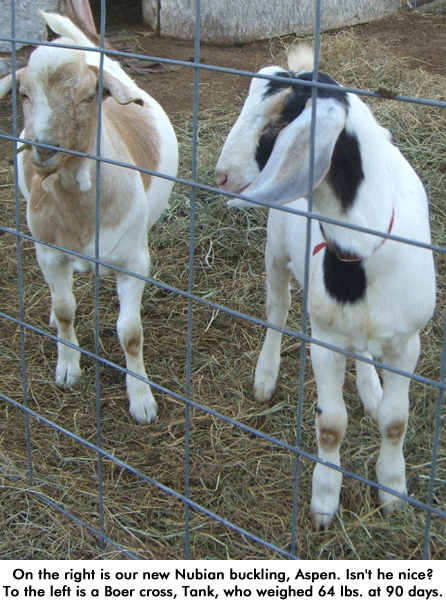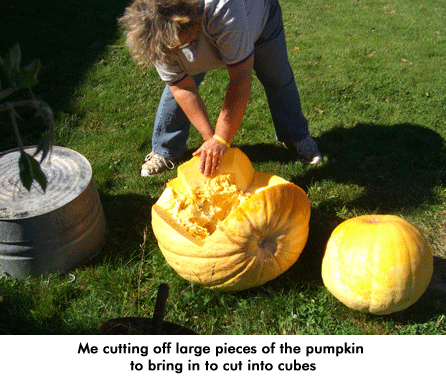After months of searching, we finally found a new spotted Nubian buck out of good milking bloodlines. His daddy is a huge, gorgeous black and white spotted registered buck and his mother is a pretty doe with a lovely udder. Not only did we find a beautiful buck, but a new friend in the owner and her sister, who is also a Backwoods Home Magazine subscriber! We had to travel 169 miles to get our goat…actually two goats, because I fell in love with one of her purebred Boar doelings, too. Carol Miller really has some nice goats! In fact, I hope to buy a registered Boar buckling from her in the spring and also bring home a huge red Nubian doe, too. I should have brought the trailer!
Yesterday I discovered that our 93 pound pumpkin, sitting in the front yard for decoration, had been frosted badly. It had dark frost spots on the top. Oh oh! I couldn’t bear to lose all that pumpkin, so I called my friend Jeri, who wanted some pumpkin to can, and she came over. We spent the morning cutting up the pumpkin and cubing the thick meat. She ended up with 19 quarts and I got 18 quarts, plus a turkey roasting pan full of slices to dehydrate. Wow. All that from one pumpkin. We’re pretty happy. (I guess it doesn’t take much to make a homesteader ecstatic…a goat or a pumpkin!)
Readers’ Questions:
Homesteader burnout
Will you please write an article on how to prevent/deal with homesteader/ prepper burnout? We retired & bought a place in Montana with the goal of living the homesteader lifestyle. Our home needed MAJOR renovation (still working on it after 9 yrs), we’ve built outbuildings, put in a small orchard, a garden and this month 75 berry bushes. We hunt & butcher/can/freeze our own meat plus we (I) can extensively. On top of all this, there’s bills to pay, meals to cook, laundry to do, shopping (2 hrs away), pets to care for/doctor, etc. We’ve been at this now 9 yrs. & it seems like all we do is work. In fact, I’m working harder now than I did when I worked full time with my career. We’ve not had a vacation since 2000 (too much work to do). We’re starting to feel our age and things, like gardening, are becoming ever harder on us physically. My husband has had 4 major surgeries in the last 4 years. We know hard times are coming and want to be prepared…but gosh, we, especially me, feel overwhelmed. I’m sure other homesteaders have faced this. We sure would welcome some advice/suggestions cause what started out as fun seems to be controlling our life and virtually all our time.
Overwhelmed
Rexford Montana
Yes, I will. This happens to a lot of homesteaders. Fortunately, there are things you can do to relieve that drowning feeling I know you have. I can’t do justice to it in the blog, but look forward to an article on this very soon. Hang in there. You can feel better! — Jackie
Processing pumpkins
How do you process pumpkins for later use?
Ralph Notch
Eagle Bend, Minnesota
To store your pumpkins, first let them lay outdoors until a threat of freezing weather. Covered, they’ll be okay in a frost, but when freezing threatens, bring them indoors. Pumpkins store best in normal household temperatures; homesteaders often stored them in the attic, which was quite warm. We recently gave our 54 pound pumpkin we raised last year to our grandson, Mason, for a jack ‘o lantern. I just kept it in our new addition all winter and summer as a decoration! And it was as solid as a rock, too.
If you want to, you can remove the seeds from pumpkins, bake them until tender, then puree and freeze the puree. But if you wish to can it, you should can up chunks, as the puree is too dense to safely can. — Jackie
Storing sweet potatoes
We just got a couple of bushels of sweet potatoes just out of the fields. What is the best way to cure them and store them?
Jim Bennett
Pelzer, South Carolina
You cure your sweet potatoes by keeping them in a very warm area for about 10 days (80 degrees), if possible. After that time, continue storing them at about 55-60 degrees. After about eight weeks, the sweet potatoes will develop their sweetness and be ready to use. Before this time, they won’t be as sweet. — Jackie
Salsa too juicy
I am making salsa from your recipe. The first batch was very good. The second batch wasn’t – too tomatoe and juicy. I redid it and poured off a lot of juice and added some brown sugar and another hot pepper and it was much better. My question is what kind of tomatoes do you use or recommend to use in making salsa? I am making some more now and using romas to try as they aren’t so juicy. I don’t use a cup of hot peppers as it is too hot for us but only a couple per batch. I have used your canning book all summer and its great and I have written a lot of notes in it. You would think I had it for years – its dogeared already. Canned tomatoes, green peppers, corn, peaches, veg soup, cherries, squash, and some other things.
Ruth Martin
Kalamazoo, Michigan
Romas and other meaty paste-type tomatoes, such as Rocky, Opalka, Polish Linguisa, and others make the best salsa, but I’ve sure used a ton of others. I thicken most of my salsa, even then, with tomato paste, which makes a bigger batch of thicker salsa. I’m tickled to hear you like my book and have already gotten lots of use out of it! (I’m working on another one, right now, full of recipes for all your storage pantry and homegrown foods!) — Jackie
Canning Polish sausage
I would love to can some pickled Polish Sausage. Do you have a recipe and/or suggestions?
Vickie Staples
Skowhegan, Maine
Sorry, but I’ve never canned pickled Polish sausage. Are there any readers out there who have and can help Vickie? — Jackie
Canning tomato juice
I have been canning for years, but it’s been awhile. I am trying to can tomatoes into juice/sauce and have been getting a good amount of acidy water on my jars. What would I be doing wrong? I have raw packed them and also hot packed them. I have cooked them down in a roaster oven. All of these methods still seem to give me the acid water.
I would love to be able to serve tomato juice to hubby without this acid water.
Marla Borders
Attica, Indiana
I’m not sure what you mean by acid water on your jars. If you mean a white film on the jars and lids, that is from minerals in your water; just wash it off with soap and water after the jars have cooled and you remove the rings. If you mean the yellowish “water” that settles out in tomato product jars, that’s just tomato juice. Just mix it up with the rest of the tomatoes when you serve it or drain it off, should you want to. You get less of that when you hot pack your tomatoes/juice, rather than pack them cold. You shouldn’t get any when you cook down your tomato sauce, as the end product is too thick to separate much. — Jackie





Canning Polish sausage. A neighbor of mine showed me years ago how to can sausage and other meats just like his daddy had done. His daddy used to pickle eggs, sausage, pigs feet and other products from the farm and then sell them to stores and such along Route 66 back when it first opened.
The key is to use 5% vinegar and _do not dilute_ it. If you have a favorite pickled egg recipe (not refrigerator pickles but true canning) it will work as long as you are using 5% vinegar. For sausage I like to use the polish that are the same size as a jumbo frank. Either buy them at the market in the hot dog section or use fresh made as long as you cook them first (just like eggs). I’ll sometimes drop in a jalapeno in each jar. I’ve also used “red hots” as well. Process just as you would eggs.
Perhaps when you talk about burnout you might be able to talk about how people can help each other. I have house and land and need help. Some people might want to get a start and learn and could help. I would be interested. Read all about the Nearings many years ago, then realized that they had a bunkhouse full of acolytes all the time. Most of us do not have that luxury.
Look at you bending over like you never fell off a roof! Gorgeous pumpkin! Blessings.
Add another for the burnout article, and here are some preliminary thoughts:
1. There is a book written which addresses *exactly* this problem. It’s by Rebecca Laughton and is called “Surviving and Thriving on the Land.” A lot of it pertains to co-op situations, but the knowledge is applicable to couples and families.
2. The Chinese have a saying, “He who finish house, die.” In other words, there’s no such thing as the end of work. It’s just a matter of how you want to spend the time (in an office or on the homestead).
3. The journey is the reward. Trite, but true. Modern thinking encourages us to think that if we just work our forty years up front, we’ll be able to be happy later on. Hence, the journey must be the reward.
4. We all must strive (and strive hard!) to leave the “if I just…” mentality (“If I can just earn another ten thousand, I’ll quit my job.” “If I can just finish weeding the carrots, I’ll be done.”) The aforementioned book will teach you how to better say, “If I just…then I’ll be done for the day” and be okay with that.
5. You WILL get your workload under control. What about taking time out during the day to pray the rosary or have afternoon tea? The work is never done, but you can enjoy the journey much more by setting aside time. You just have to COMMIT to doing that.
6. Take pictures! I find it extremely helpful to take before and after photos, because they serve as visual confirmation that you are indeed getting a lot done. Otherwise, it can feel like you’re spinning your wheels because the work never seems to end. But, if you have a visual track record of what you’ve accomplished, it feels much better.
Best of luck to you!
Add one more to the list of those interested in the homestead burnout tips…..
I understand that in order to gain more freedom in one set of areas means losing some in other areas, and it’s not a mistake to choose homesteading….and it depends on what a person’s idea of fun is (LOL)…..but a break of some kind is always a good thing, if it’s at all possible to do…..
The new additions to your herd are adorable Jackie! Agree on the need for that burnout article. We all work so hard to keep our homesteads going!
Oh my goodness, Aspen is beautiful!!!
Re homesteader burnout: I’ll add a second request for that article and hope to see it soon.
Comments are closed.